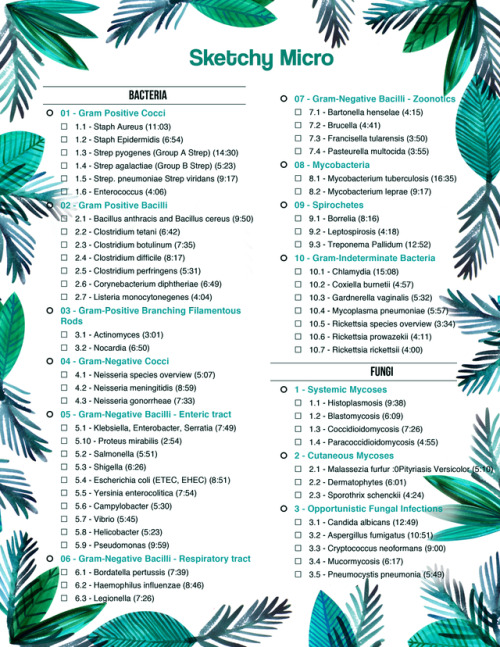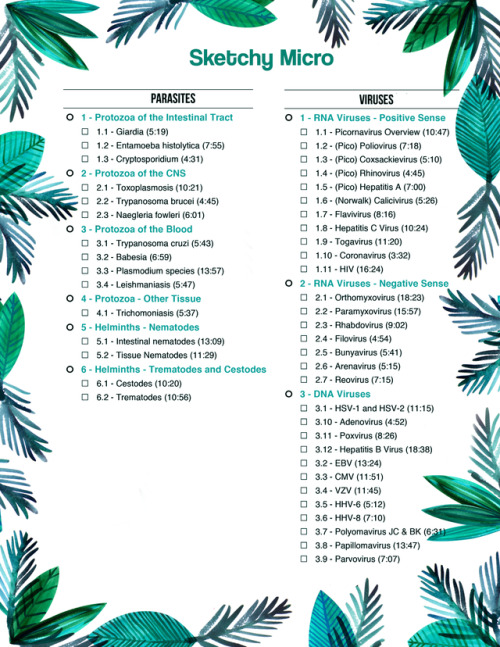Desmosome A Circular, Dense Body That Forms The Site Of Attachment Between Certain Epithelial Cells,

desmosome a circular, dense body that forms the site of attachment between certain epithelial cells, especially those of stratified epithelium of the epidermis, which consist of local differentiations of the apposing cell membranes.
-Exfoliatin
A staphylococcus toxin - Cleaves the desmosomes in the stratum granulosum - Separates layers of skin. - Example: Scalded skin syndrome (occurs more often in infants)
More Posts from T-b-a-blr-blog and Others

Scale of Infectious Dose def: the AMOUNT of pathogen (ie NUMBER of organisms) required for cause infection in a host.
How to remember Lysteria monocytogenes tumbling motility?
MICROBIOLOGY MNEMONIC
So, Lysteria rhymes with Hysteria, and when I think of hysteria I think of someone dancing Hysterically…..(actually, me dancing hysterically..)
I also googled Hysteria, and found this:

HYSTERIA RADIO!
So here it goes: “Lysteria dances to Hysteria Radio”
If I don’t come up with all these silly associations my brain melts and confuses all the freakin bacterias, so bear with me…
Microbiology Genetics
Transformation
Conjugation: F+ –> F- & Hfr –> F-
Transposition
Transduction: Generalized & Specialized


Sketchy Micro To Do List:
• 01 - Gram Positive Cocci o 1.1 - Staph Aureus (11:03) o 1.2 - Staph Epidermidis (6:54) o 1.3 - Strep pyogenes (Group A Strep) (14:30) o 1.4 - Strep agalactiae (Group B Strep) (5:23) o 1.5 - Strep. pneumoniae Strep viridans (9:17) o 1.6 - Enterococcus (4:06) • 02 - Gram Positive Bacilli o 2.1 - Bacillus anthracis and Bacillus cereus (9:50) o 2.2 - Clostridium tetani (6:42) o 2.3 - Clostridium botulinum (7:35) o 2.4 - Clostridium difficile (8:17) o 2.5 - Clostridium perfringens (5:31) o 2.6 - Corynebacterium diphtheriae (6:49) o 2.7 - Listeria monocytonegenes (4:04) • 03 - Gram-Positive Branching Filamentous Rods o 3.1 - Actinomyces (3:01) o 3.2 - Nocardia (6:50) • 04 - Gram-Negative Cocci o 4.1 - Neisseria species overview (5:07) o 4.2 - Neisseria meningitidis (8:59) o 4.3 - Neisseria gonorrheae (7:33) • 05 - Gram-Negative Bacilli - Enteric tract o 5.1 - Klebsiella, Enterobacter, Serratia (7:49) o 5.10 - Proteus mirabilis (2:54) o 5.2 - Salmonella (5:51) o 5.3 - Shigella (6:26) o 5.4 - Escherichia coli (ETEC, EHEC) (8:51) o 5.5 - Yersinia enterocolitica (7:54) o 5.6 - Campylobacter (5:30) o 5.7 - Vibrio (5:45) o 5.8 - Helicobacter (5:23) o 5.9 - Pseudomonas (9:59) • 06 - Gram-Negative Bacilli - Respiratory tract o 6.1 - Bordatella pertussis (7:39) o 6.2 - Haemophilus influenzae (8:46) o 6.3 - Legionella (7:26)
• 07 - Gram-Negative Bacilli - Zoonotics o 7.1 - Bartonella henselae (4:15) o 7.2 - Brucella (4:41) o 7.3 - Francisella tularensis (3:50) o 7.4 - Pasteurella multocida (3:55) • 08 - Mycobacteria o 8.1 - Mycobacterium tuberculosis (16:35) o 8.2 - Mycobacterium leprae (9:17) • 09 - Spirochetes o 9.1 - Borrelia (8:16) o 9.2 - Leptospirosis (4:18) o 9.3 - Treponema Pallidum (12:52) • 10 - Gram-Indeterminate Bacteria o 10.1 - Chlamydia (15:08) o 10.2 - Coxiella burnetii (4:57) o 10.3 - Gardnerella vaginalis (5:32) o 10.4 - Mycoplasma pneumoniae (5:57) o 10.5 - Rickettsia species overview (3:34) o 10.6 - Rickettsia prowazekii (4:11) o 10.7 - Rickettsia rickettsii (4:00) • Fungi • 1 - Systemic Mycoses o 1.1 - Histoplasmosis (9:38) o 1.2 - Blastomycosis (6:09) o 1.3 - Coccidioidomycosis (7:26) o 1.4 - Paracoccidioidomycosis (4:55) • 2 - Cutaneous Mycoses o 2.1 - Malassezia furfur :0Pityriasis Versicolor (5:10) o 2.2 - Dermatophytes (6:01) o 2.3 - Sporothrix schenckii (4:24) • 3 - Opportunistic Fungal Infections o 3.1 - Candida albicans (12:49) o 3.2 - Aspergillus fumigatus (10:51) o 3.3 - Cryptococcus neoformans (9:00) o 3.4 - Mucormycosis (6:17) o 3.5 - Pneumocystis pneumonia (5:49)
• Parasites • 1 - Protozoa of the Intestinal Tract o 1.1 - Giardia (5:19) o 1.2 - Entamoeba histolytica (7:55) o 1.3 - Cryptosporidium (4:31) • 2 - Protozoa of the CNS o 2.1 - Toxoplasmosis (10:21) o 2.2 - Trypanosoma brucei (4:45) o 2.3 - Naegleria fowleri (6:01) • 3 - Protozoa of the Blood o 3.1 - Trypanosoma cruzi (5:43) o 3.2 - Babesia (6:59) o 3.3 - Plasmodium species (13:57) o 3.4 - Leishmaniasis (5:47) • 4 - Protozoa - Other Tissue o 4.1 - Trichomoniasis (5:37) • 5 - Helminths - Nematodes o 5.1 - Intestinal nematodes (13:09) o 5.2 - Tissue Nematodes (11:29) • 6 - Helminths - Trematodes and Cestodes o 6.1 - Cestodes (10:20) o 6.2 - Trematodes (10:56)
• Viruses • 1 - RNA Viruses - Positive Sense o 1.1 - Picornavirus Overview (10:47) o 1.2 - (Pico) Poliovirus (7:18) o 1.3 - (Pico) Coxsackievirus (5:10) o 1.4 - (Pico) Rhinovirus (4:45) o 1.5 - (Pico) Hepatitis A (7:00) o 1.6 - (Norwalk) Calicivirus (5:26) o 1.7 - Flavivirus (8:16) o 1.8 - Hepatitis C Virus (10:24) o 1.9 - Togavirus (11:20) o 1.10 - Coronavirus (3:32) o 1.11 - HIV (16:24) • 2 - RNA Viruses - Negative Sense o 2.1 - Orthomyxovirus (18:23) o 2.2 - Paramyxovirus (15:57) o 2.3 - Rhabdovirus (9:02) o 2.4 - Filovirus (4:54) o 2.5 - Bunyavirus (5:41) o 2.6 - Arenavirus (5:15) o 2.7 - Reovirus (7:15) • 3 - DNA Viruses o 3.1 - HSV-1 and HSV-2 (11:15) o 3.10 - Adenovirus (4:52) o 3.11 - Poxvirus (8:26) o 3.12 - Hepatitis B Virus (18:38) o 3.2 - EBV (13:24) o 3.3 - CMV (11:51) o 3.4 - VZV (11:45) o 3.5 - HHV-6 (5:12) o 3.6 - HHV-8 (7:10) o 3.7 - Polyomavirus JC & BK (6:31) o 3.8 - Papillomavirus (13:47) o 3.9 - Parvovirus (7:07)

be patient, good things are coming your way :)
Remember to use your sponge to replace any bacteria on your dishes accidentally removed by the act of eating.
Microbiology professor (via scienceprofessorquotes)
Tularemia
An infection common in wild rodents that is passed to humans through contact with infected animal tissues or by ticks, biting flies, and mosquitoes.
Also known as rabbit fever and deer fly fever, amongst others.

Cysteine Growth Requirements
MICROBIOLOGY MNEMONIC
BoyFriend Lost Penis
B rucella
F rancisella
L egionella
P asteurella
or….
The four sisters “Ella” worship in the “cystein” chapel
Brucella
Francisella
Legionella
Pasteurella

Palmoplantar Rash - Secondary Syphilis
classically a generalised polymorphic rash
usually non-itchy, often affecting palms + soles
important to exclude HIV seroconversion
similar appearance to “target lesions” of erythema multiforme
diagnosis —> syphilis serology

Elementary body of Chlamydia trachomatis in a conjunctival scrapping in a patient with trachoma: Trachoma is the MCC of preventive global blindness
-
 paureus reblogged this · 5 years ago
paureus reblogged this · 5 years ago -
 angelaellar reblogged this · 5 years ago
angelaellar reblogged this · 5 years ago -
 t-b-a-blr-blog reblogged this · 6 years ago
t-b-a-blr-blog reblogged this · 6 years ago -
 t-b-a-blr-blog liked this · 6 years ago
t-b-a-blr-blog liked this · 6 years ago -
 trypanosomacrazy7-blog liked this · 7 years ago
trypanosomacrazy7-blog liked this · 7 years ago -
 zhuykay-blog reblogged this · 8 years ago
zhuykay-blog reblogged this · 8 years ago -
 bioluminescentvoid liked this · 11 years ago
bioluminescentvoid liked this · 11 years ago -
 borzoo reblogged this · 12 years ago
borzoo reblogged this · 12 years ago -
 borzoo liked this · 12 years ago
borzoo liked this · 12 years ago -
 yasasiihitogomi reblogged this · 12 years ago
yasasiihitogomi reblogged this · 12 years ago -
 nakeya52 liked this · 12 years ago
nakeya52 liked this · 12 years ago -
 psychedelicamphetamines liked this · 12 years ago
psychedelicamphetamines liked this · 12 years ago -
 usmlestudyaids-blog reblogged this · 12 years ago
usmlestudyaids-blog reblogged this · 12 years ago -
 mynotes4usmle reblogged this · 12 years ago
mynotes4usmle reblogged this · 12 years ago -
 salibonani-blog-blog reblogged this · 12 years ago
salibonani-blog-blog reblogged this · 12 years ago -
 educationjourney reblogged this · 13 years ago
educationjourney reblogged this · 13 years ago